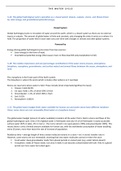THE WATER CYCLE
5.1A: The global hydrological cycle's operation as a closed system (inputs, outputs, stores, and flows) driven
by solar energy and gravitational potential energy.
Closed System
Global hydrological cycle is circulation of water around the earth, which is a closed system as there are no external
inputs or outputs. The amount of global water is finite and constant, only changing the state it exists as or where it is
held. The proportion of water held in each state vary over time with changes in climate and other global systems.
Powered by
Energy driving global hydrological cycle comes from two sources:
Solar energy (in the form of heat)
Gravitational potential energy (that causes rivers to flow downhill and precipitation to fall)
5.1B: The relative importance and size (percentage contribution) of the water stores (oceans, atmosphere,
biosphere, cryosphere, groundwater, and surface water) and annual fluxes between the ocean, atmosphere, and
land.
The cryosphere is the frozen part of the Earth system.
The biosphere is where life exists (which includes other spheres so it overlaps)
Stores are reservoirs where water is held. These include (most important/significant to least)
1. Oceans: holds 96.9%
2. Ice caps: holds 1.9%, of which 69% is fresh
3. Groundwater: 1.1%, of which 30% is fresh
4. Soil: 0.01%
5. Atmosphere: 0.001%
5.1C: The global water budget limits water available for human use and water stores have different residence
times; some stores are non-renewable (fossil water or cryosphere losses)
The global water budget (amount of water available) considers all the water that is held in stores and flows of the
global hydrological cycle. Only 2.5% of global water is freshwater and only 1% of all freshwater is easily accessible
surface water (52% in lakes, 1% in rivers) – the rest is stored in ice caps/ glaciers (70%) and groundwater (30%). This
means there is only a limited amount available for human use, with the worldwide consumption of water doubling
every 20 years, more than twice the rate of increase of population.
Residence time = average length of time a water molecule remains in a store = vol. in store/ transfer rate in
However, some stores are non-renewable, meaning that new water molecules cannot re-enter the store
Fossil water: deep groundwater made from pluvial periods in ancient past (e.g. under Sahara desert)
Cryosphere: made of frozen water, but once it melts it can become contaminated with salt. Only in a glacial
period can more water be locked again.
,5.2A: The hydrological cycle is a system of linked processes: inputs (precipitation patterns and types: orographic,
frontal, convectional); flows (interception, infiltration, direct runoff, saturated overland flow, throughflow,
percolation, groundwater flow) and outputs (evaporation, transpiration, and channel flow).
Inputs
Main input is precipitation, which has a lot of factors that affect the drainage basin
Amount: can have direct impact on the drainage discharge
Type of precipitation: e.g. formation of snow can act as a temporary store – when it melts, large fluxes of
water can be released into the system
Distribution within basin: significant in very large basins e.g. Nile/Ganges, where tributaries start in different
climate zones
Variability:
o Secular variability happens long term, e.g. result of climate change trends
o Periodic variability happens annually, seasonally, monthly or diurnal (daily) context
o Stochastic variability results from random factors e.g. in localisation of a thunderstorm in a basin
Intensity: greater intensity, greater likelihood of flooding
Seasonality: patterns of precipitation depending on time of year and geographical area
Types of Rainfall
Orographic rainfall:
1. Warm wet air is forced to rise over high land
2. As the air rises, it cools and condenses. Cloud form and precipitation occurs on high land, causing water to
travel down
3. Drier air descends and warms
4. Any moisture in air evaporates
Frontal rainfall:
1. Any area of warm air meets an area of cold air
2. Warm air is forced over the cold air
3. Where the air meets, the warm air is cooled and water vapour condenses
, 4. Clouds form and precipitation occurs
Convection Rainfall:
1. Sun heats the ground and warm air rises
2. As air rises, it cools and condenses to form clouds
3. Large cumulonimbus clouds are formed
4. Heavy rain and storms occur – include thunder and lightning
Flows
Interception - The interruption of precipitation by vegetation
Some of the intercepted water will evaporate off the surface of the leaves and return to the atmospheric store –
known as interception loss. It can also evaporate from inside the leave via transpiration.
Water can also travel via throughfall (through spaces of leaves) and stemflow (trickles along branches, down trunk)
to reach the ground.
Infiltration - The process where water soaks into or absorbed by the soil
Surface runoff - The movement of water that is not confined by a channel and occurs when the water does not
infiltrate
Channel flow - Eventually surface flow enters a channel, and cohesion of water allows a confined path for water to
eventually go to sea
Throughfall - the downward movement of water through vegetation
Percolation - After infiltration, the movement of water through the soil and permeable rocks
Groundwater flow - the transfer of percolated water through permeable or porous rocks
Outputs
Evaporation - the process where moisture is lost directly into the atmosphere





